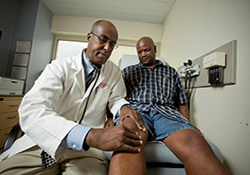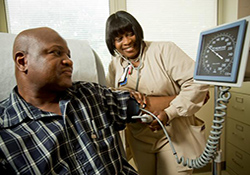Office of Research & Development |
 |
Office of Research & Development |
 |

VA Research Currents archive
Posted September 13, 2013
(Fall 2013 VA Research Currents; online ahead of print)

Dr. Said Ibrahim examines Lawrence Woodson at the Philadelphia VA Medical Center. Ibrahim's research has focused on why African American patients with osteoarthritis of the knee are less likely than white patients to consider joint replacement. (Photo by Tommy Leonardi)
Joint-replacement surgery has been shown to be one of the most effective treatments for end-stage knee osteoarthritis. It relieves pain in more than 90 percent of patients. Most need no help walking once they recover. But African Americans are less likely than whites to consider it as an option. As a result, they are up to five times less likely to undergo the procedure. VA researcher Said Ibrahim, MD, MPH, calls it "one of the most marked disparities in health care."
He and his colleagues aim to change that. Earlier this year, in the May 2013 issue of Arthritis and Rheumatism, they reported on an educational intervention that increased the rates at which African American patients with knee osteoarthritis engaged their providers in discussions about knee replacements and received referrals for orthopedic consults.
The intervention has two parts. One is a "decision aid" in the form of a 40-minute educational video about treatment options for knee osteoarthritis. The video is by the Foundation for Informed Medical Decision Making. The other part is a single session of counseling based on motivational interviewing. The counseling technique, shown effective in hundreds of studies, builds on patients' own internal desire to make positive changes.
The study included 639 African American patients at the Philadelphia, Pittsburgh, and Cleveland VA medical centers. All the patients had moderate to severe osteoarthritis of the knee. They were randomly assigned to one of four groups. One group watched the video. A second watched the video and received counseling afterward. A third received only counseling. An additional group was given an educational booklet on osteoarthritis that did not specifically talk about joint replacement.
Patient willingness to consider joint replacement jumped from 67 to 75 percent, on average, at the one-month follow-up among those who had received any intervention. At one year, patients in the intervention groups were more likely than those in the control group to report that they talked to their provider about knee pain (92 versus 85 percent), got a referral to an orthopedic surgeon (18 versus 13 percent), and, for those with referrals, attended an orthopedic consult (61 versus 50 percent).
Ibrahim is an investigator with VA's Center for Health Equity Research and Promotion. He is also associate chief of staff for research at the Philadelphia VA Medical Center. He says the intervention was based on earlier studies by his group that documented the gap between African Americans and whites in the use of joint replacement, and explored the underlying reasons.
Ibrahim: "We did surveys to identify the potential differentiating factors between African Americans and whites that could explain the disparities, and we found that one key factor was lack of knowledge among African Americans about the treatment itself. That's how we made the decision to use the video—it provides exactly the information we think African Americans need to feel comfortable with this treatment."

Nurse Charlene Baker checks Lawrence Woodson's blood pressure at the Philadelphia VA Medical Center. (Photo by Tommy Leonardi)
One of those early studies, from 2002, showed that African Americans were less likely than whites to be familiar with joint replacement and more likely to expect a longer hospital stay and pain and disability following surgery. Consequently, they were less willing to consider the therapy.
"Overall, we found that African American patients generally know little about the benefits and risks of joint replacement," says Ibrahim. "We thought providing education in an evidence-based way would bring these patients up to par with other groups that are more likely to consider this treatment."
While the video itself is not geared to any particular ethnic group, the motivational interviewing—conducted by minority counselors—is intended to address any cultural gaps in the education. "The interviewing is intended to supplement any cultural differences in response to the video," says Ibrahim.
He stresses that the aim of the research is not to promote any one treatment. "The goal is not to 'sell' joint replacements, but to help patients focus on the issue at hand and move them from a position of ambivalence to one of action, where they feel more comfortable making a decision."
Ibrahim points out that as common as osteoarthritis is in the U.S.—it's the leading cause of disability—Veterans may be at increased risk, due to the joint trauma experienced by many during training or deployment.
He adds that the VA health care system, where access is not limited by insurance, is an ideal setting in which to study how preferences affect health care utilization—particularly when it comes to elective procedures such as joint replacement.
"This is an elective treatment," says Ibrahim. "Physicians don't look you in the eye and say, 'This is what you need to do.'" Patients have more latitude to exert their preference, and "we know that preference is very heavily influenced by culture and social background."
In light of the results of the trial, Ibrahim and colleagues write, "We now have a low-cost, noninvasive, patient-centered intervention that could potentially increase access to orthopedic care for minority patients who are candidates for joint replacement in the management of end-stage osteoarthritis."
The work was supported by VA's Health Services Research and Development Service and the National Institute of Arthritis and Musculoskeletal and Skin Diseases.